Introduction
Public relations activities range from program planning which means analyzing problems and opportunities, defining goals and planning activities (Daramola, 2003). It measures results, for the progress of the organization (Aiyende et al., 2020b; Fayemi et al., 2020b; Fayemi et al., 2020c, Fayemi et al., 2020d; Olabanjo et al., 2020b; Omokiti et al., 2020a). This way, public relations activations play a vital role in connecting the public all over the world and enabling them to discuss mutual concerns and solutions (Omokiti, et al., 2020a). However, James et al (2020b) opine that the presence of PR in the government is not new; it carries the responsibility of disseminating information to the citizens of a country to make them fully aware of the government’s activities (Hong, 2014). Public relations’ activations and tools enhance housing development which can likely shape the common environment, reputation, developer’s actions, and perceptions of the local population to be served (James et al., 2020a; Ndubueze et al., 2020b, James et al., 2020b; James et al., 2020c; Ndubueze et al., 2020; Nejo et al., 2020a; Olabanjo et al., 2019).
Access to suitable affordable housing and property is a fundamental human right. The provision of modern housing schemes and the transformation of slums and ghettos in Lagos dates back to 1928 with the inauguration of the Lagos Executive Development Board (L.E.D.B.); among other things, the L.E.D.B. was chiefly charged with the task of getting rid of the filth and unhealthy living conditions that existed in Lagos at that time. The Board also intended to transform the slum areas and ghettos into a planned and habitable setting. Though the Board was the sole planning and development authority in central Lagos and its surroundings, the Lagos City Council was responsible for maintaining its highways, drains and open spaces. Also shared with the City Council was the approval of construction plans, an uncomfortable process that always resulted in delays in approving building plans. The attendant frustration of private developers often led to developers breaching planning regulations. However, subsequent urban expansion required the involvement of the Ikeja Area Planning Authority (I.A.P.A) in controlling the development and supply of public housing outside the city. On the one hand, the (I.A.P.A) had full powers to monitor building plans and private development in its area of jurisdiction, but such plans had to be forwarded to the appropriate local health authorization council. With the establishment of Lagos State in 1967, the need to curb the lack of proper coordination between the existing planning authorities involved and the unnecessary dissipation of energy without meaningful results necessitated the formation of a central body to be charged with the responsibilities of the various bodies. Consequently, the Lagos Executive Development Board (L.E.D.B.), the Ikeja Area Planning Authority (I.A.P.A.) and the Epe Town Planning Authority (E.T.P.A.) metamorphosed into what is now known as the Lagos State Development and Property Corporation (L.S.D.P.C). This metamorphosis was granted legality by the L.S.D.P.C. Edict No. 1 of 1972.
The way housing is perceived and consumed influences a range of factors. A major constraint on housing choices is the availability and supply of new homes, which, despite some recent efforts, lags significantly behind housing demand (NHPAU, 2009). There are also cultural influences that make the way people live or view their identity and belonging to a home important (Savage, Bagnall & Longhurst, 2006). There are also strong demographic pressures on demand, as increased longevity and solitary living patterns mean household growth rates are higher than population growth rates (NHPAU, 2009). Residential property is now primarily seen as an investment rather than good use and is now contributing to financial planning for a household (Smith & Searle, 2006). Every investment is dependent on land, in some way or another. The land is the key component of the private sector, national and local investment, far-reaching land-related projects, tax collection, land re-adjustment, expropriation, and other similar socio-economic applications (Candas, Flacke & Yomralioglu, 2016).
Though land value is one of the most important data required for all these investments and applications, the “true value” is typically difficult to predict. Assessing the value of land by assessing many factors related to real estate, e.g., location, climate, topography, conditions of use, etc., is called the valuation of real estate, which is a key factor in land management. Planning process land use can influence the supply and range of housing produced in both new development and redevelopment areas. With the rapid population growth that resulted in the illegal construction of residential buildings on the way of utilities and transportation, one needs to consider the local housing and property values (Prasetyo, & Putri, 2018).
Statement of the Problem
The rate at which housing and properties are being sold is of interest to this study because an average individual wants to own a house or at least a property but the process of getting any of these things dissatisfies the members of the public; when it comes to issuing of getting original documents of any property and the troubles such individual faces in owning a building is quite discouraging. According to SDG 9, which encompasses industry, innovation and infrastructure, Lagos State Development and Property Corporation must be able to provide their operations/duties following these goals. One of the major problems public relations faces has to do with assumptions, therefore, this research seeks to investigate Public Perceptions on the activations of the Ministry for Housing: A focus on Lagos state development and property corporation.
Objectives of the Study
The research aims to examine public expectations regarding the Lagos state construction and property corporation’s activations. A major objective of the study is to examine, from the public viewpoint, the public relations practices of the Lagos State Development and Property Corporation. Another objective is to investigate the impact of LSDPC’s public relations activations on public groups.
Literature Review
According to Grawe, Daugherty and Dant (2012), practitioners operating as service providers are commonly limited to advocating organizational viewpoints. This role prevents them from helping the company develop and sustain long-term partnerships that guarantee long-term organizational performance, requiring some adjustment to public expectations and needs. In establishing and maintaining organizational legitimacy, a company or organization that has a sound public relations philosophy works unceasingly to build and maintain a good reputation on which present and future operations depend. Companies that have survived for decades, or even centuries, have built a good image based mainly on their ‘bonding’ with their various publics which public relations is all about (Metzler 2001, p. 321). Public relations has achieved a secure place in the corporate structure. Significant expenditure for public relations programs is essential.
However, Ledingham (2018) noted that the relational viewpoint holds that PR combines the needs of organizations and the public through organizational-public relations management. The idea of managing relationships has several advantages and organizational objectives. Such goals often go beyond profitability to encompass social and even political objectives. Ledingham claims, among others, convincingly that the relational viewpoint is a reasonable unit assessment of the influence of public relations in the organization-public relationship. Ratio dimensions can define an organization-public relationship which, in turn, can act as a predictor of public perception and choice behaviour and, most importantly, the result of effective relationship management is mutual understanding and benefit. The point is that an organization that manages its relationship with the public has a high chance of positive perception which often leads to higher patronage of the company’s product and, ultimately, higher profitability.
Relationship management is the core of public relations in every modern sense, in particular where organizational success is involved. Several researchers argue that a “relationship should be constructed to ensure the corporate bottom line’s effectiveness” (Jo, 2006, p. 227). Although many admit that public relations is useful within an organizational framework, they also observed that the contributions of public relations are difficult to measure. The seeming difficulty in measuring public relations’ contributions to organizational effectiveness and performance is often exaggerated because of obsession with quantification as life depends entirely on figures and statistics. In real-life situations, everything is not reduced to figures alone. In this case, the use of digital public relations practices also helps in enhancing existing relationships with the public (Salau, et al., 2020).
Housing Affordability
Affordable housing is the supply of houses for less than market value for sale or rent. This includes a housing with voucher assistance systems depending on the location and the tenant; housing built with low-income tax credits for rent; and affordable housing. ‘Affordable housing’ was used as an alternative to words like ‘public’ housing, ‘private’ housing or ‘low cost’ (Smith & Searle, 2006; NHPAU, 2009), p6). Practical interpretations of what constitutes affordable housing are typically unique to the context of the policies and services they are used in. However, they typically have common features such as a notion of what is affordable, and a reference to the target group(s) for which they are intended. Creating awareness and impacting personnel is a paramount function every ministry should embrace to attract diaspora partnerships (Adelua, et al., 2020a; Adelua, et al., 2020b; James et al., 2020d; Nwosu et al., 2019; Adelua, et al., 2020c; Adelua, et al., 2020d; Aiyende al., 2020a).
The complexity surrounding affordability means that there is no single measure to assess the nature and degree of affordable housing issues. Therefore, the challenge is to identify the policy needs around the issues and to develop measures relevant to the policy requirements for identifying the scale and shape of the problem; assessing consumer patterns in housing, informing policy-making or offering business feedback (Smith & Searle, 2006; NHPAU, 2009). Quantitative tests may show that there is a problem with affordability but do not propose solutions (Smith & Searle, 2006; NHPAU, 2009).
Additionally, the affordability of households can be experienced in a variety of ways; that is, through employment, transportation, health and other consumption by individuals, single parents and couples with children who adapt their circumstances to high housing costs and/or low incomes (Smith & Searle, 2006; NHPAU, 2009). Smith and Searle (2006) firmly argue in favour of an affordability approach to residual income because ‘housing costs continue to be inflexible and make the first claim on after-tax income for most households.’ The disadvantage of this approach, though, is that it relies on subjective household spending assumptions. It is pointed out in NHPAU (2009) that several studies that review low-income housing issues recognize the utility of residual housing cost measures. The preference for most researchers has been to deploy a ratio measure because of the perceived difficulties of defining measurement criteria. Ministers of Planning accept that the design and provision of affordable housing using planning frameworks is a major contributor to sustainable communities based on the three-pronged approach to sustainability through cultural, environmental and social improvements (NHPAU, 2009).
How Affordable Housing Affects Surrounding Property Values
According to Smith & Searle (2006), the key to understanding this conundrum is to identify those particular housing, neighbourhood or regional economic conditions that may depress or, in many cases, even stabilize and strengthen the values of neighbouring properties. A clearer delineation and comprehension of these requirements helps developers, builders and public representatives, to make better-informed decisions which can lead to better outcomes.
Theoretical Framework
Excellence Theory (Grunig, 2001; Grunig & Hunt, 1984; Grunig & Grunig, 2010) explains the value of public relations when organizations apply the process in the system, thus contributing to good relations with strategic audiences, helping an organization to develop and achieve desired goals, reduce negative advertising, and increase revenue by providing stakeholder-needed products and services. As defined in this theory, to balance expectations, property development organizations must optimize the value of public relations. Nonetheless, internal and external contact and partnership should be based on the principle of excellence.
Research Methodology
This aspect deals with the tools used to collect data from the area of study. The questionnaire is the instrument used to collect data; it consists of a series of questions. A survey research design with 200 respondents from selected publics in Alausa Ikeja, Lagos state, Nigeria, was drawn using stratified random sampling. The two hundred (200) open and closed-ended questionnaires contain two sections, section A and section B. The first section is about respondents’ perceptions of the activations of the ministry for housing while the second section consists of demographic questions. The series of questions is aimed at eliciting information and getting answers to the research questions.
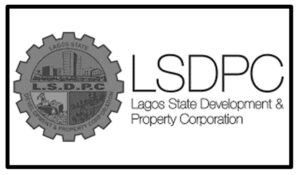
Fig. 1: The logo of LSDPC
Source: Google
Data Analysis and Presentations
Table 1: Awareness of LSDPC

Table 1 illustrates that 131 (65.5%) respondents know about LSDPC while 69 (34.5%) respondents do not know at all.
Table 2: Awareness of any community relations activities of LSDPC
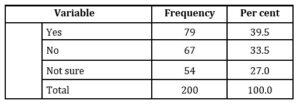
The above table indicates that 79 (39.5%) respondents know about community relations’ activities being carried out by LSDPC, 67 (33.5%)
respondents do not know, and 54 (27.0%) respondents are not sure if community relations’ activities are being carried out by LSDPC.
Table 3: Public updating of policies, activities and general information about LSDPC programmes

According to Table 3, 84 (42.0%) respondents said the corporation keeps up to date with new policies, activities and general information about
their programmes, 71 (35.5%) respondents said they don’t, while 45 (22.5%) were not sure if they do.
Table 4: Known activities of LSDPC
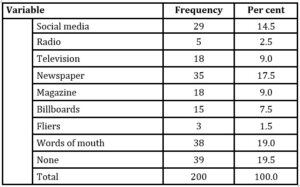
Table 4 shows the type of activities respondents are aware of, 15 (7.5%) respondents know Press releases, 18 (9.0%) respondents know corporate promotions, 29 (14.5%) respondents know Tv adverts, 35 (17.5%) respondents know Newspaper adverts, 8 (4.0%) respondents know
Annual general meetings, 7 (3.5%) respondents know Specialized trade fairs, 78 (39.0%) respondents know None of these activities, while 10 (5.0%) respondents stated “Others” as a means of activities they are aware of.
Table 5: Sources of public awareness of LSDPC activities
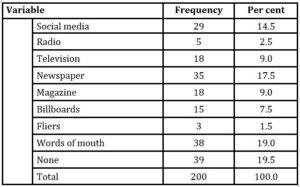
Talking about how respondents became aware of those activities, Table 4 shows 29 (14.5%) respondents said through social media, 5 (2.5%) respondents said through Radio, 18 (9.0%) respondents said Television, 35 (17.5%) said Newspaper, 18 (9.0%) respondents said Magazine, 15 (7.5%) respondents said Billboards, 3 (1.5%) respondents said fliers, 38 (19.0%) said through Word of Mouth, and 39 (19.5%) respondents said none.
Table 6: Impact of LSDPC’s activities on respondents
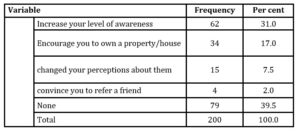
Table 6 stated the impact of these activities on respondents. 62 (31.0%) respondents said their awareness Increased, 34 (17.0%) respondents said they encourage them to own a property/house, 15 (7.5%) respondents said they changed their perceptions about the corporation, 4 (2.0%) said they convinced them to the point of referring a friend, while 79 (39.5%) respondents said None.
Table 7: Public satisfaction with LSDPC’s activities

The above Table 7 shows that 93 (46.5%) respondents are satisfied with these activities, 84 (42.0%) respondents are not satisfied, meanwhile, 23 (11.5%) respondents are just indifferent about the whole thing.
Table 8: Public perceptions of the PR practices of LSDPC
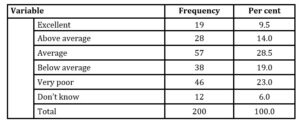
According to how respondents rated the frequency of the practices of LSDPC in Table 7, 19 (9.5%) said Excellent, 28 (14.0%) said Above average, 57 (28.5%) said Average, 38 (19.0%) said Below Average, 46 (23.0%) said Very poor, while 12 (6.0%) Don’t know.
Table 9: Suggestions to improve LSDPC’s information dissemination
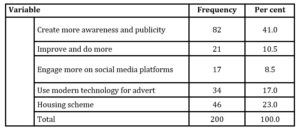
And the following are what the respondents think in Table 9, 82 (41.0%) said they should create more awareness and publicity, 21 (10.5%) said they should improve and do more, 17 (8.5%) said they should try and engage more on social media platforms, 34 (17.0%) respondents said they should use modern technology for an advert, while 46 (23.0%) respondents said housing scheme.
Table 10: Demographic Characteristics of Respondents (n = 200)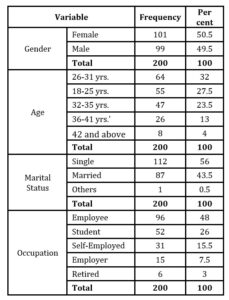
Table 10 shows that 99 (49.5%) Males and 101 (50.5%) Females responded. It also shows the ages respondents fall into; 55 (27.5%) are between 18-25, 64 (32.0%) are between 26-31, 47 (23.5%) are between 32-45, 26 (13.0%) are between 36-41, and then 8 (13.0%) are between 42 and above. According to the Table, 61 (43.5%) respondents are married, 112 (56.0%) respondents are single, and 1 (.5%) respondent is divorced. Lastly, it shows that 52 (26.0%) respondents are Students, 96 (48.0%) respondents are employees, 15 (7.5%) respondents are employers, 31 (15.5%) respondents are self-employed and 6 (3.0%) respondents are retired.
Discussion of Findings
According to the outcome of the analysis obtained, the majority of the respondents in Table 1 know about the corporation but these percentages of respondents in Table 2 are not aware of the community relations activities being carried out by LSDPC. Meanwhile, in Table 3, a minority of the respondents said the corporation keeps up to date with new policies, activities and general information about their programs.
According to Table 4, the corporation’s activities are unknown to the majority of the respondents. However, few could identify Newspaper adverts (which are the traditional media) to be the type of activities they are aware of. As a result of this, these activities have no impact on the majority of the respondents while the larger number/percentages of respondents said none of these activities has any form of impact on them.
Finally, in Table 9, respondents stated ways the corporation can improve its information dissemination and other public relations functions; a higher number of the respondents in numbers/percentages said they should “create more awareness and publicity”, while some others suggested they should “engage more on social media platforms”.
Conclusion
Based on the results of this report, it is clear that it has been learned that more needs to be done when it comes to educating and increasing awareness of the company’s activities and procedures because not everyone who cares about the organization is aware of their activations that they participate in or introduce. Also, the public’s view of the Lagos State Development and Property Corporation’s image is not entirely positive, because the public thinks that everything they do is either bad or Good, so, that’s why, Intentional steps must be taken by the corporation not only to let the public know what they are doing, but also to let them know how all their activities, as they may affect the public, are carried out and, at the same time, to carry the public through these different activities.
It is imperative to create a meaningful two-way relationship which comes with a mutual understanding that helps the public get all of the information of interest to them and vice versa. It is important to note that the confiscation or modification of the property must be straightforward, fair and acceptable to all stakeholders involved in the projects (Pievatolo, 2016). And those demands have grown as changing media and increased access to information-on-demand put greater pressure on organizations to be accessible, sensitive and transparent. (Odiboh, Olonode, Adesina, and Yartey, 2018)
Recommendations
The study recommends the improvement of the public relations office because the corporation already has an established public relations department and experts in the field that work directly with the members of the public, but still, the corporation needs to get its public relations tools right and properly engage their publics in communicating their activations because the publics of an organization are its most important stakeholders with whom relationships need to be developed. Therefore, Lagos State Development and Property Corporation need to do more in building substantial relationships with the public by always communicating their healthy activations, facilities and expertise. Public relations in any organisation are the messages communicated and the relationships established with your public. As LSDPC practices public relations, it will improve the company’s brand, connect with the community, and boost its marketing efforts. Consistent, strategic messaging with the end goal of building and nurturing public relations is key to the success of any organization. In other words, good public relations are the key to LSDPC ‘s success; and they need to do a better job of keeping their audiences aware of the things they do every day. In addition, public relations initiatives conducted by the ministry and agency should be stepped up with greater public knowledge (Nwosu, et al. 2020a; Nejo, et el., 2020b; Olabanjo et al., 2020a; Omokiti et al., 2020b; Salau et al., 2020a; Salau et al., 2020b; Nwosu et al., 2020b).
References
- Adelua, M., Odiboh, O., James, D., Aiyende, O., Omokiti, O., Nejo, O. and Salau, J. (2020), “Professional perception of community relations activities of the Lagos state ministry, council for arts and culture”. Proceedings of the 35th International Business Information Management Association (IBIMA), ISBN: 978-0-9998551-2-6, 10-11 April 2019, Granada, Spain.
- Adelua, M., Odiboh, O., James, D., Aiyende, O., Omokiti, O., Nejo, O. and Salau, J. (2020), “Awareness and Impact of Community relations activities of Lagos State Ministry of Tourism, Council for Art and Culture” Proceedings of the 35th International Business Information Management Association (IBIMA), ISBN: 978-0-9998551-2-6, 10-11 April 2019, Granada, Spain.
- Aiyende, O., Odiboh, O., James, D., Adelua, M., Omokiti, O., Nejo, O. and Salau, J. (2020), “Usage of Electronic Public Relations by Practitioners On the Activities of Lagos State Transport Ministry: Lastma” Proceedings of the 34rd International Business Information Management Association (IBIMA), ISBN: 978-0-9998551-2-6, 10-11 April, 2019, Granada, Spain.
- Aiyende, O., Odiboh, O., James, D., Adelua, M., Omokiti, O., Nejo, O. and Salau, J. (2020). “Public Perception and Awareness of Electronic Public Relations On the Activities of Lagos State Traffic Management Authority: Lastma” Proceedings of the 34rd International Business Information Management Association (IBIMA), ISBN: 978-0-9998551-2-6, 10-11 April, 2019, Granada, Spain.
- Candas, E., Flacke, J. and Yomralioglu T. (2016), Understanding Urban Regeneration in Turkey. ISPRS-International Archives of the Photogrammetry, Remote Sensing and Spatial Information Sciences, XLI-B4, 669-675. doi:10.5194/isprs-archives-xli-b4-669-2016.
- Daramola, AC. (2003), Fundamentals of Professional Public Relations: A Global Overview. Lagos: CMCIN.
- Fayemi, O., Odiboh, O., Adelua, M., James, D., Nwosu, E., Olabanjo, O. and Ndubueze, N. (2019), “Professional Public Relations Practices in Secondary Schools in Nigeria” Proceedings of the 33rd International Business Information Management Association (IBIMA), ISBN: 978-0-9998551-2-6, 10-11 April, 2019, Granada, Spain.
- Fayemi, O., Odiboh, O., Nejo, O., Aiyende, O., James, D., Adelua, M., Omokiti, O. and Salau, J. (2020), “Professional Public Relations Activations and Tools Used by Lagos State Development and Property Corporation” Proceedings of the 33rd International Business Information Management Association (IBIMA), ISBN: 978-0-9998551-2-6, 10-11 April, 2019, Granada, Spain.
- Grawe, SJ., Daugherty, PJ. and Dant, RP. (2012), Logistics Service Providers and Their Customers: Gaining Commitment Through Organizational Implants. Journal of Business Logistics, 33(1), 50-63. doi:10.1111/j.0000-0000.2011.01037x.
- Grunig, J. (2001), ‘Two-way symmetrical public relations: past, present, and future,’ in Handbook of public relations, SAGE Publications, Inc., Thousand Oaks, CA, 11-30, viewed 4 June 2020, doi: 10.4135/9781452220727.n1.
- Grunig, JE. and Hunt, T. (1984), Managing public relations. Aurora, Illinois: Cengage Learning.
- Grunig, JE., Grunig, LA. and Dozier, DM. (Eds.). (2010), Public Relations Theory II (2nd Ed.). New York: Routledge.
- Hong, H. (2014), The Internet transparency and government-public relationships in Seoul, South Korea. Public Relations Review, 40(3), 500-502. doi: 10.1016/j.pubrev.2014.01.011.
- James, D., Odiboh, O., Nejo, O., Aiyende, O., Adelua, M. and Salau, J. (2020), “Public relations activations and awareness in Ministry of education Lagos State” Proceedings of the 34th International Business Information Management Association (IBIMA), ISBN: 978-0-9998551-2-6, 10-11 April 2019, Granada, Spain.
- James, D., Odiboh, O., Nejo, O., Aiyende, O., Adelua, M. and Salau, J. (2020), “Public perception and awareness of public relations activations of Lagos State SUBEB” Proceedings of the 34th International Business Information Management Association (IBIMA), ISBN: 978-0-9998551-2-6, 10-11 April 2019, Granada, Spain.
- Jo, S. (2006), Measurement of Organization Public Relationship Validation of Measurement using a manufacturer-retailer relationship in Adoory L. (Ed.) Journal of Public Relations Research 18(3).
- Ledingham, JA. (2018), Explicating Relationship Management as a General Theory of Public Relations in Hon. L. C. Journal of Public Relations 15(2).
- Metzler, MS. (2001), “The Centrality of Organizational Legitimacy to Public Relations Practice. In R. L. Health. Handbook of Public Relations. California: Sage.
- (2009), Housing Requirements and the Impact of Recent Economic and Demographic Change. Fareham, National Housing and Planning Advice Unit.
- Nejo, O., Odiboh, O., Aiyende, O., James, D., Adelua, M., Omokiti, O. and Salau, J. (2020), “Awareness & Impact of the Public Relations Activities of Lagos State Ministry of the Environment in Promoting Environmental Sustainability: A Focus on LASPARK” Proceedings of the 34th International Business Information Management Association (IBIMA), ISBN: 978-0-9998551-2-6, 10-11 April 2019, Granada, Spain.
- Nejo, O., Odiboh, O., Aiyende, O., James, D., Adelua, M., Omokiti, O. and Salau, J. (2020), “The Public Relations Activities of Lagos State Ministry of the Environment in Promoting Environmental Sustainability: Its Impact and Awareness on the Public. A Focus on LASPARK” Proceedings of the 34th International Business Information Management Association (IBIMA), ISBN: 978-0-9998551-2-6, 10-11 April 2019, Granada, Spain.
- Odiboh, O., Olonode, A., Adesina, E. and Yartey, D. (2018), Influence of e-communication and digital culture on Nigeria’s indigenous socio-cultural systems: A focus on Abeokuta and Ota, Nigeria. Proceedings of the 4th International Conference on Information Management (ICIM2018), Oxford University, Oxford UK.
- Omokiti O., Odiboh, Nejo, O., O., Aiyende, O., James, D., Adelua, M. and Salau, J. (2020), “Health Information and Awareness of Social Media: Perception of Patients of Selected Primary Health Care Centers, Yaba, Lagos-state” Proceedings of the 34th International Business Information Management Association (IBIMA), ISBN: 978-0-9998551-2-6, 10-11 April 2019, Granada, Spain.
- Omokiti O., Odiboh, Nejo, O., O., Aiyende, O., James, D., Adelua, M. and Salau, J. (2020), “Awareness and Usage of Social Media as e-Public Relations Tool in Ministry of Health, a study of Lagos State Primary Health Care Board” Proceedings of the 34th International Business Information Management Association (IBIMA), ISBN: 978-0-9998551-2-6, 10-11 April 2019, Granada, Spain.
- Pievatolo, MC. (2016), Friends have all things in common: property, publishing, and politics. doi:10.31235/osf.io/mwfnk.
- Prasetyo, B. and Putri, RY. (2018), Relations of Political Interest in Local Development. Proceedings of the 4th International Conference on Contemporary Social and Political Affairs. doi:10.5220/0008817501070112.
- Savage, M., Bagnall, G. and Longhurst, B. (2006), Globalisation and Belonging. London: Sage Publications.
- Salau, J., Odiboh, Nejo, O., O., Aiyende, O., James, D., Adelua, M. and Omokiti O. (2020), “Perception of Farmers On Digital Media Usage and Agricultural Information: A Study of Selected Farmers in Lagos State” Proceedings of the 35th International Business Information Management Association (IBIMA), ISBN: 978-0-9998551-2- 6, 10-11 April 2019, Granada, Spain.
- Smith, S. and Searle, B. (2006), ‘Dematerialising Money? Observations on the Flow of Wealth from Housing to Other Things.’ Housing Studies, 23(1) 21–43.













